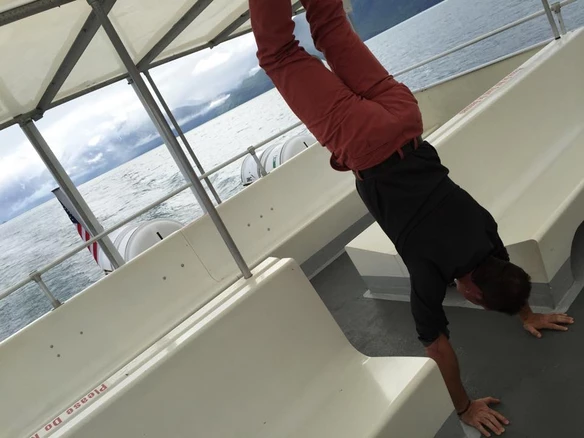
North to Alaska

Finn’s handstand on Prince William Sound 🙂
Alaska is big.
It is really, really big. When put inside the lower 48 states of the USA, Alaska stretches from coast to coast and is bigger than California, Texas and Montana combined.
Yet in population Alaska is the third smallest state with under one-million inhabitants scattered across an area so vast that many Alaskans themselves will never visit their whole state.
The superlatives are mind-numbing. Up to 24 hours light during the summer months and eternal night in winter. 17 of the 20 highest peaks in the United States.

In the ‘Last Frontier’ group travel dominates tourism
Thousands of islands, many more thousand rivers and creeks, millions of lakes and billion of trees. Trillions upon trillions of mosquitoes and traditionally a distinctly male population (though much less so these days) – so for single women (and some single men) it is said; “the odds are good, but the goods are odd!”
The most dangerous animal in Alaska is the moose – not so much due to aggressiveness, rather from surprise during night-time driving.
Dog-sledding is the official sport. Gold is the official mineral and Alaska in the USA’s largest producer of salmon, crab, halibut and herring.
I have been travelling to Alaska for many years and am currently up here leading a couple of custom tours designed for some special clients.

This is the End ….
I love Alaska, but as always find it difficult to:
A) want to do far more than is financially (or logistically) possible, and –
B) to integrate such massive territory, random history and incongruent topography into a unified concept.
I remember going through a challenging branding (identity building) of my home town, which leaves me wondering how Alaska can even be a brand.
Yet Alaska is a brand that resonates throughout the world.
People are almost universally pro-Alaska and they want to visit… but I am not always sure they know what to expect.

Finn and I visiting with the ‘national bird’ 🙂
Much of the state is entirely inaccessible (full-stop) and the road network is limited. The cruise industry dominates much of the tourism experience, yet the majority of Alaskans live in greater Anchorage and up through Fairbanks in Alaska’s Golden Heart. These are not cruise destinations.
In classically resigned northern humour Alaskans will happily joke the mosquito is the state bird!
Much of Alaska’s population is very transient in origin. I happily speak Spanish with people, many long-term residents and most of the summer-time tourism staff come from almost everywhere else. It is always surprising to meet some many people from Florida working here and even many Eastern Europeans on short summertime visas.

The Alaska Pipeline across from the North Slope to Valdez – this is the current economic driver in the State
Of course Alaska has a reasonably large indigenous population. Barrow, located at the northern arctic tip of the region is home to a large Inupiat (Eskimo) population. At the southern extreme in Ketichan Tlingit, Haida and Tsimshian totem poles have become a major attraction to cruise passengers.
Throughout the state are native populations and some people who have managed to maintain their ancient and pre-colonial identity while embracing aspects of the American world in which they are citizens. Some have found this balance more challenging.
Alaska is so big and so much of a dream, I can only introduce it as a whole and hope to gradually introduce specific areas and topics as individual blogs. Some places or themes I hope to explore are:
- The Gold Rush and the Yukon
- Interior Alaska
- Coastal Alaska
- Island Alaska
- Alaskan wildlife & parks
- Touring Alaska
- Alaskan wilderness
Like what you’ve read? Subscribe to our newsletter!
* indicates required
Email Address *
Please follow and like us:

#alaska #anchorage #fairbanks
